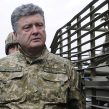
Transnistria-Type Scenario Looming in Ukraine’s Donbas (Part Two)
Publication: Eurasia Daily Monitor Volume: 11 Issue: 147
By:

Building a giant version of Transnistria in Ukraine’s Donetsk and Luhansk provinces (Donbas) is Russia’s current policy, but it was not its start-off option. It became a fall-back plan when Moscow’s even more ambitious “Novorossiya” project failed (at least temporarily) in the other six provinces of Ukraine’s east and south (see Part One in EDM, August 8). Accordingly, by early May of this year, Moscow proceeded to set up the Donetsk and Luhansk “people’s republics” (DPR, LPR) in territories seized from Ukraine through armed force. While still envisioning the DPR-LPR as the nucleus of a would-be Novorossiya, the Kremlin concentrates for the time being on consolidating the DPR-LPR as a project in its own right. This project fits in many ways into Russia’s classic “frozen conflict” paradigm (see EDM, July 11).
Ukrainian observers soon recognized the Transnistria model was being updated and applied to the Donbas. In his first speech to the Parliamentary Assembly of the Council of Europe (PACE), Ukrainian President Petro Poroshenko vowed that he would “not let the Donbas be turned into a Transnistria” (Ukrinform, June 21). From Kyiv, the Donbas is viewed as a “Transnistria East,” with overlapping characteristics (Kyiv Post, August 6).
“DPR’s” leaders openly invoke the “frozen conflict” in Transnistria as a paradigm-setter and fount of experience in building a state entity, unrecognized internationally but protected by Moscow, and subverting the target country. The top figures in Donetsk (the founding “prime minister” Aleksandr Boroday [“deputy prime minister” since August 7], military commander Igor Girkin/Strelkov, “first deputy prime minister” and “state security” chief Vladimir Antyufeyev) are all veterans of the Transnistria conflict, and they underscore that connection when speaking to local and international media in Donetsk (see EDM, July 15, 30). A team of 40 experts in the “state building” of Transnistria (administration and internal security) has joined Antyufeyev to Donetsk as of early August (Kyiv Post, August 5).
Nationalist opinion in Russia views Transnistria as an integral part of “Novorossiya,” along with the much larger Donbas area. This is not Russian government policy, but it could well become policy in the event that Russia opens an overland corridor from either the Donbas or Crimea to Odessa (see Part One in EDM, August 8).
As case studies, Donbas and Transnistria are analogous, but not identical. The dissimilarities and specific nuances (see Part One in EDM, August 8) are no less instructive than the compelling analogies. The shared characteristics include:
1) Imperial legacy of the forced linguistic russification of non-Russians. As a result, Russian is the hegemonic language although Russians are the minority ethnicity in both cases. This situation enables Moscow and the secessionist leaders to portray the populations as a “Russian-speaking” amalgam, entitled to Moscow’s protection or inclusion into the “Russian World.”
2) Russia underwrites the territory’s separation to undermine the country’s Western-oriented government and destabilize the country’s politics. Moscow and the would-be “republics” build leverage through the permanent threat of full and irreversible secession while stopping just short of consummating that move.
3) The secessionist leaders seize power through armed force, and faster than the rest of the country or the West comprehend what is happening. Russia’s “hybrid warfare” against Ukraine in 2014 innovates by multiplying the instruments of warfare; but it is a familiar method at its core since Transnistria 1992. There, Russian paramilitaries, coordinated by army and intelligence officers, took over the seats of local authority in a process remarkably similar to what the world saw in Slovyansk, Kramatorsk, Luhansk and throughout Donbas in the spring of 2014. Inflammatory propaganda on Russian television also played a key role in Transnistria 1992. To be sure, the 2014 revised edition was a much improved one. As Chris Donnelly, the co-head of the Oxford-based Institute for Statecraft, observes, this method “isn’t new as far as the Russians are concerned… I think we have lost our collective memory about it” (House of Commons Defence Committee—Third Report: “Towards the next Defence and Security Review: Part Two-NATO,” July 22).
4) Once in the seat of power, the would-be “republic’s” leaders take their instructions directly from Moscow and fully identify with Russia’s geopolitical agenda in the region. A protracted (“frozen”) conflict ensues. To overcome the deadlock, Western diplomacy tries shifting the onus on the country-target of aggression to demonstrate peaceful intent through unilateral concessions (unilateral ceasefire, changes to constitution).
5) Moscow and the secessionist leaders offer to negotiate the country’s reunification on such terms as would empower the “republics” to block the country’s Western orientation. The method proposed on and off is “federalization” of Ukraine or Moldova. On the entire Eurasian and European land mass, Moscow plays with no other “federalization” (“confederalization”) projects but those in Ukraine and Moldova.
6) Moscow portrays the conflict as internal to the target country (civil conflict), instead of the state-on-state conflict that it actually is. The legitimate national government is compelled to negotiate with Russia’s proxies in the secessionist “republics.” Russia positions itself as a third-party arbiter, entitled to oversee an eventual settlement. Despite the target country’s Western orientation, the West largely accepts Russia’s terms of reference. The Organization for Security and Cooperation in Europe (OSCE) is engaged to handle the situation, although the OSCE is itself hobbled by Russia’s internal veto power. This has been the pattern of negotiations on Transnistria for at least 15 years, and it came fairly close to being emulated in Ukraine’s case in 2014 (Geneva declaration in April, OSCE road map in May, Contact Group format in June, Berlin declaration in July). Ukraine seems to have broken out of that pattern by now, thanks in large measure to Ukraine’s capacity to launch a military counter-offensive. Moldova, however, lacks that capacity.




